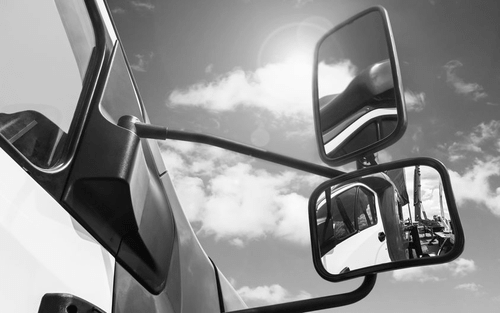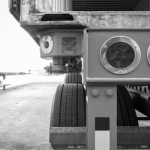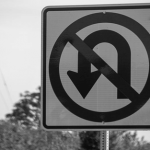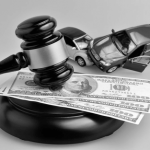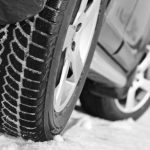Backing up a commercial motor vehicle is very dangerous and deadly, especially to pedestrians. Because backing a commercial motor vehicle is more dangerous than a regular vehicle, there are special safety rules and duties that apply to truck drivers.
Federal Regulations
The Federal Motor Carrier Safety Regulations (FMCSR) (contained in the Code of Federal Regulations) govern the operation of commercial motor vehicles in interstate commerce (between two states). 49 C.F.R. § 383.110 requires that a state (like North Dakota) include in the knowledge and skills tests that it administers to CDL (commercial drivers license) applicants specific items related to safe driving operation. 49 C.F.R. § 383.111 requires all commercial motor vehicle drivers to have knowledge of safe backing while driving. In living up to its obligation under the federal regulations, North Dakota has included specific instruction in safe backing in its own CDL Manual.
North Dakota CDL Manual-Safe Backing Instruction
The North Dakota CDL Manual includes “minimum testing standards for the licensing of commercial drivers.” Section 2 of the North Dakota CDL Manual is titled “Driving Safely”. Within Section 2, subsection 2.2.4 addresses “Backing Safely”.
Specifically, subsection 2.2.4 states:
Because you cannot see everything behind your vehicle, backing is always dangerous. Avoid backing whenever you can. When you park, try to park so you will be able to pull forward when you leave. When you have to back, here are a few simple safety rules:
- Start in the proper position
- Look at your path
- Use mirrors on both sides
- Back slowly
- Back and turn toward the driver’s side whenever possible
- Use a helper whenever possible
- These rules are discussed in turn below
Start in the Proper Position. Put the vehicle in the best position to allow you to back safely. This position will depend on the type of backing to be done.
Look at Your Path. Look at your line of travel before you begin. Get out and walk around the vehicle. Check your clearance to the sides and overhead, in and near the path your vehicle will take.
Use Mirrors on Both Sides. Check the outside mirrors on both sides frequently. Get out of the vehicle and check your path if you are unsure.
Back Slowly. Always back as slow as possible. Use the lowest reverse gear. That way you can more easily correct any steering errors. You can also stop quickly if necessary.
Back and Turn Toward the Driver’s Side. Back to the driver’s side so you can see better. Backing toward the right side is very dangerous because you can’t see as well. If you back and turn toward the driver’s side, you can watch the rear of your vehicle by looking out the side window. Use driver-side backing–even if it means going around the block to put your vehicle in this position. The added safety is worth it.
Use a Helper. Use a helper when you can. There are blind spots you can’t see. That’s why a helper is important. The helper should stand near the back of your vehicle where you can see the helper. Before you begin backing, work out a set of hand signals that you both understand. Agree on a signal for “stop.”
As you can see from the details of subsection 2.2.4, backing is dangerous and a task that needs to be taken seriously by every driver of a commercial motor vehicle. Failure to live up to these duties and rules may have catastrophic consequences. These consequences can include serious injuries or death to pedestrians due to the nature of where backing occurs.
Requirements of Rear Vision Mirrors while Backing
In addition to the duties and rules mentioned above, there are requirements related to the use of rear vision mirrors. 49 C.F.R. § 392.7(a) is clear: a commercial motor vehicle shall not be driven (including backing) without rear vision mirrors attached and in good working order. On top of that, 49 C.F.R. § 393.80 requires that “every bus, truck, and truck-tractor shall be equipped with two rear-vision mirrors, one at each side”. In addition, North Dakota Administrative Code § 38-04-01-02 adopts both of these federal regulations into North Dakota law related to the operation of intrastate (within North Dakota only) commerce.
Additional Safety Reminders for Trucks with the Upcoming North Dakota Winter Driving
As you may recall, we have addressed the different duties and safety rules that apply to drivers of commercial motor vehicles when driving on North Dakota roads. Two prior blogs have dealt with safe speed, including safe speed and driving in North Dakota winter weather. For a review of those prior blogs, please visit the following links:
Safe Speed is Important for Semis on the Road
Trucking Accidents: Know the Rules for Trucks Driving in North Dakota Weather
Conclusion
As has been said before on this blog, we have a deep respect for the trucking industry and fully understand that without trucking, most (if not all) of the things we use day-to-day in our houses, work, and personal life would not be available. At the same time, our team has sat in the living rooms of too many families who have endured tremendous loss because a loved one has been killed or catastrophically injured when a truck driver (or more often the company they work for) decided safety was not a priority. Our hope is one day our team never has to visit another family in their home to discuss the death or catastrophic injury of their loved one and that safety ultimately prevails as a top priority. Until then, we understand the importance of taking unsafe behavior to task through a lawsuit to hopefully save the next person and family from a tremendous loss.
This area of the law is highly technical and it is important you have an attorney who understands the huge difference between a regular car crash and one involving a commercial motor vehicle. If you or a loved one has been catastrophically injured or killed in an accident involving a commercial motor vehicle, it is very important you hire an attorney who knows trucking law and regulations. Our personal injury team at SW&L Attorneys understands, knows, and handles all trucking and commercial motor vehicle accidents. To get in touch with our team, call 701-297-2890 or email us via the contact form below.
The information contained in this article and on this website is for informational purposes only.


